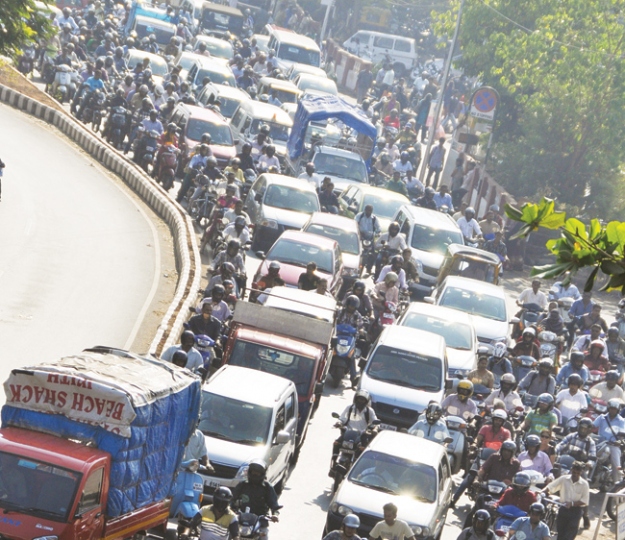Indisciplined parking and a substantial
increase in the numbers and sizes of cars have resulted in the choking of
streets in most Goan cities. The result of which is that there is hardly any room
for pedestrians. In Panjim, pedestrians have been further strained by the new plan
for one-way vehicular movement, which has led to an increase in vehicular speeds,
making it dangerous for pedestrians to cross roads. In ideal cities the pedestrians
are supposed to rule the road, but in our cities they are forced to risk life
and limb every time they step on the street.
At a
public consultation held by the City Corporation of Panjim (CCP) on 27 November
2015, to receive public feedback on Smart City proposals, Commissioner Sanjith
Rodrigues recounted the problems the authorities face while implementing
parking rules, despite employing contractors to clamp vehicles which flaunt these
rules. An example he cited was of the no-parking area in front of the Caculo Mall
in Panjim; some vehicle owners would apparently park their vehicles right in
front of the mall, challenge the authorities to clamp them, proceed to have a
meal inside the mall and, on their return, not only pay the fine but also offer
an extra amount as a tip, and then drive off with glee. This vile kind of
display of entitlement seems widespread in Goa nowadays.
Financial deterrents through fines are usually
not adequate to discourage people from abusing the law (since the biggest
law-breakers are usually the wealthy and powerful in any case!). But the
efficient clamping by the contractor did help in bringing about some limited form
of traffic discipline within the city. This, however, did not last long as the
Panjim Councillors decided, a few months back, to dispense with the services of
the said contractor (O Heraldo: 13 Aug. 2015). The city
representatives probably succumbed to the pressure applied by elite vehicle
owners and high-end shopping patrons. As a result, unlawful parking, whether in
front of Caculo mall or other parts of the city, continues unabated and engaged
in by many more.
The elite car owners dislike being ‘policed’ by
‘ordinary’ clamping workers or police constables, even if they have the money
for the fine. So, even when their cars were parked illegally, many vehicle owners
would abuse these workers who were simply doing their job. This desire to flaunt one’s power and privilege
by flouting the rules is a typical structural problem which emerges from the
graded hierarchy of the caste system, where the privileged are always assumed
to be right even when they are legally not.
The historic character of Goan towns is their
compact built environment. Widening of
streets to accommodate more cars is only going to destroy this unique character.
Moreover, widening of roads to ease vehicular traffic is a vicious cycle: the
wider the roads, the more the numbers of cars, leading to more traffic jams.
Bangalore is an excellent example of a city which has lost its character
because of rampant road widening and innumerable flyovers. Despite these technological
interventions, however, the time taken to get from one place to another has not
reduced; on the contrary the opposite has happened. To make matters worse
Bangalore’s pedestrian life has been completely compromised.
Given this situation, rather than discussing
how to make more space for individually owned cars, citizens must debate how to make the city free
of them. In his article End of the car age: how
cities are outgrowing the automobile (The Guardian:
28 Apr. 2015), Stephen Moss argues that cities around the
world are coming to the same conclusion: they’d be better off with far fewer
cars. In order to
achieve this, the city needs to adopt a vision in which residents no longer
rely on their cars but on efficient and respectful public transport.
The citizens of Panjim, who are discussing how
to make their city smart, need to make some tough decisions, without which the
city will soon come to a grinding halt. There is an urgent need to expel the
cars from the city and make way for efficient public transport, cyclists and
pedestrians. One great example we can learn from is the case of Amsterdam. Journalist
Renate van der Zee (The Guardian: 5 May 2015) writes
that although cyclists rule in the Dutch capital today, great pains had to be
taken initially to accommodate them. Zee argues that it was because of the
tough decisions taken in the 1970s that contemporary Amsterdam (or for that
matter the whole of The Netherlands) is equipped with an elaborate network of
cycle-paths and lanes, so safe and comfortable that even children and elderly
people use bikes as the easiest mode of transport.
It is time for Panjim to go the Dutch way. World-over,
more than the technological infrastructure installed by experts it is the
actions of inspired citizens that make a city smart. It is only thanks to
fierce activism, writes Renate, that Amsterdam has succeeded in becoming what
it is, now: the bicycle capital of the world. The smart city, then, is really about
wise citizens, who canvass for the right kind of smart systems.

